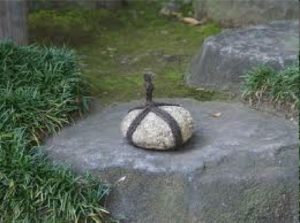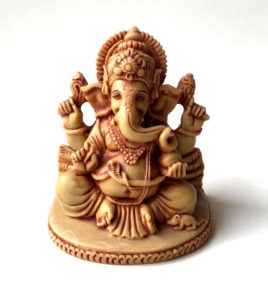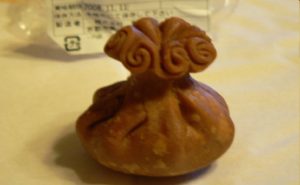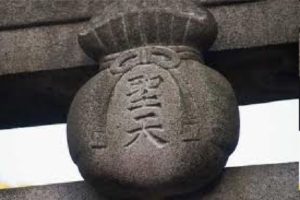Sekimori Ishi and Ganesha

The garden of a Teahouse is called a ro-ji, 露地, dew-ground, which has a path leading from the outside world to the Teahouse. A roji should have no flowering plants, but rather, evergreen trees and plants such as ferns, moss, bamboo, etc. Sen no Rikyū believed that the ideal roji has only moss, koke, 苔, covering the ground, but as people might get their feet wet, it has a pathway made of steppingstones, tobi-ishi, 飛石, fly-stone.
The roji may have paths branching off the main route, and to mark where the guest should not walk, a stone is placed a little way in, indicating that the way is blocked. The stone is called a seki-mori-ishi, 関守石,barrier-guard-stone. The stone, about the size of a human heart, is tied with rope, warabi-nawa, 蕨縄, fernbrake-rope. There are various ways to tie the rope, but it should have enough rope to form a kind of handle.

The seki–mori–ishi, 関守石, barrier-guard-stone, may symbolically represent Ganesha, the teacher of the Buddha. In Japan, Ganesha is called Kan-ki-ten, 歓喜天, Delight-joy-heaven. Ganesha, the elephant-headed god and son Parvati and Shiva, is the god of obstacles and learning. He is depicted with two arms, as well as four and more. Some believe he must have four hands. In his hands he holds an axe, while in the other he holds a rope. The rope is spiritual knowledge which helps us to remove ourselves from the samsara, material world, in which we are entrenched.
In Indian lore, Parvati wished to bathe, and before immersing herself in the bath, she cleansed her skin with powdered sandalwood. After she scraped the sandalwood from her skin, she formed it into a boy. She asked him to guard her doorway, and to let no one in. Her husband, Shiva, came to her door, but was barred by his son, whom he did not know. In anger, Shiva cut off his son’s head. Parvati, learning of the problem, vowed to destroy the world. Shiva commanded his followers to take the head of the first living thing that they found. They found an elephant, cut off its head, and gave it to Shiva, who placed it on the boy’s body. He called his son Ganesha, which means group-leader.
Ganesha grew and became adored, and was given many offerings including sweets called modak, sweetened rice balls. He over-indulged in them and became full so that his belly became huge and round. He was walking about and stumbled over a mouse, so that he fell and burst open his belly. He put the sweet treats back in his belly, and found a snake that he wound around his belly to hold it closed.


The ancient sweet called kan-ki-dan, 歓喜団, delight-joy-ball, originated in Tang China, and came to Japan in the Nara period. It is presently made at Kame–ya Kiyo–naga, 亀屋清永, Tortoise-house Pure-ever in Kyōto. This type of sweet is still made throughout India and is called modak, or modaka. The form is quite similar, but the filling varies greatly. The modak is the favorite sweet treat of Ganesha. Kan-ki, 歓, is a standard expression meaning great joy and delight. The pronunciation of the name of Ganesha with the same characters is Kangi plus the word ten.

The drawstring may be likened to the snake that Ganesha wrapped around his belly, and thus the bag may represent his belly. Many gods of good fortune often have big bellies, rather like the treasure bags held by Dai-koku, 大黒, Big-black, and Ho-tei, 布袋, Cloth-bag, whose name is a bag.
Ganesha, in Japan, is called Kan-gi-ten, 歓喜天, Delight-joy-heaven [god], and Shō-ten, 聖天, Sacred-heaven [god], as well as by many other names. Kan-ki written with different characters, 官紀, official-discipline, government account, narrative. Another word, kan-ki, 喚起, call-rouse, means arousal, excitation, awakening, evocation, call forth, etc. Both have some identification with the nature of Ganesha and Kangiten.
With regard to Ganesha’s teaching of the Buddha and others, the word awakening seems more relative. The words seki mori meaning barrier, may be wordplay with seki-mori, 赤傅, red-tutor, which means a tutor to a prince. Ganesha, who is colored red, was the tutor/teacher to prince Gautama, the young Buddha. In addition, the word ishi may imply i-shi, 医師, doctor-master. Ganesha as remover of obstacles is regarded and prayed to as a healer.
The snake that Ganesha wrapped around his burst-open stomach was a cobra. The most familiar cobra with great symbolism is black, perhaps a black mamba, and is highly poisonous. Perhaps there is a connection between the blackness of the cobra with the blackness of the warabi nawa, the black fern rope tied around the stone.
In a Japanese tale, a sleeping snake was speared through by growing reeds. He woke and found himself unable to move. He saw fern bracken growing with their soft curled heads. He asked them to help. They raised him off of the reeds. He thanked them. Since then, snakes show gratitude toward brackens by behaving politely toward them. When walking in the woods one should carry some bracken to avoid snakes. Whatever the truth of the tale, the Japanese make a connection between ferns and snakes. The sound that snakes make is likened to zuru–zuru and nyoro–nyoro.

The old name for kami-dasuki, 神襷, god-strap, this fern-like plant is also known as hi-kage no kazura, 日陰蔓, sun-hidden ’s vine. The name clubmoss comes from the upright seedpods that look like little clubs. The family of lycopodium plants resemble fir and other pines; the needles resemble sugi, cedar. Sugi koke, 杉苔, cedar moss, is the preferred moss covering the ground of the roji. The cedar tree is highly esteemed by many cultures around the world.
When Amaterasu, the sun goddess, shut herself in the Cave of Heaven, Amenouzume, the heaven’s turning, tied her sleeves back with kami-dasuki, and danced before the multitude of gods hoping to coax Amaterasu from the cave. The crowd laughed at the dancer. Curious, Amaterasu rolled back the stone that blocked the cave entrance, came out and returned her light to the world. The kami-dasuki in a way helped to remove the obstacle of the stone that blocked the cave entrance.
